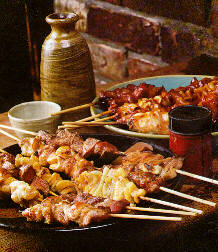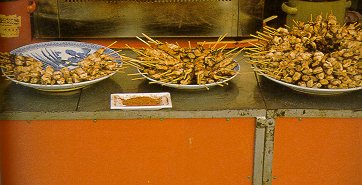
Yakitori

Yakitori refers to meat skewered and then grilled. The mean can be chicken, pig and cow innards and chicken skin. The meat is dipped into a barbecue sauce and beer is often drunk when eating yakitori.The sauce is referred to as tare and the quality of the charcoal used both influence the final taste of the yakitori. The meat is not the only thing on the stick, though, as leeks and other vegetable pieces may also be used.
The pieces of chicken used include sasami (tender white-meat chicken breast fillets), chicken-leg chunks, livers and other organs, tsukune or ground-chicken meatballs and chicken skin. In addition to leeks you will also find mushrooms, green peppers, ginkgo nuts and even small quail eggs sometimes used.
There are usually two skewers per order. Although the chicken has already been dipped in a soy-based sauce or has had salt added you may also sprinkle the chicken with shichimi, a mixture of red pepper and six other spices.
During the sixth century, due to Buddhist influence, the Japanese stopped eating beef and pork, thus making chicken a main meat. So the grilling of chicken on skewers can be dated to near that period of time. A cookbook in 1643 expanded the meats to be skewered, including duck, pheasant, skylark, quail and pigeon.
With the state-sponsored suppression of Buddhism after the Meiji Restoration (1868) the other meats again became popular. Places specializing in yakitori are called yakitori-ya. These places are not necessarily fancy, however, often being small, smoky form the grilling of the meat, and with a generally cozy atmosphere. The restaurants put out small red lanterns in front with the character for tori or bird written on it. Some of the fancier places will even use asparagus, rabbit or sparow as part of the skewered food.
p>Yakitoria has become kind of a snack food. It's fast to fix, taking about a minute to cook. In this age of health-food consciousness some places now use range-free chicken called jidori which is tougher than ordinary chicken but is more flavorful.
Each kind of skewer preparation has its own name: yakitori for those using chicken pieces; aigamo if duck is used; hasami if alternating pieces of chicken and leek are used; hatsu if chicken hearts are used; for very young chicken; hone tsuki if bones are included; kawa for chicken skin; tori kimo yaki for chicken livers and other giblets; momo for chicken legs; motsu for giblets; nankotsu for chicken pieces with bone; rebaa for liver; shooniku for boneless meat with skin; sunagimo for gizzards; suzume for sparrow or young chicken; tan for beef tongue; tebasaki for chicken wings; tsukune for chicken meatballs, and uzura for quail eggs.

|